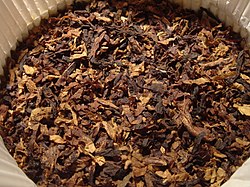Pīpwēod

Pīpƿēod is ƿyrtcræftig forþbǣru geƿōrht of þǣm lēafum of ƿyrta on þǣre cnōsle Nicotiana. Hēo mōt ƿesan geeten, genotod sƿā gecyndelic ƿōlcƿellend and, on þǣm gecynde nicoten tartrate , hēo is gebrocen on sumum lǣcedōmum.[1] On nytte hēo gemǣnost ēoƿaþ on þǣm gecynde of berēcunge, cēoƿunge, ēðunge, pīpƿēode settunge, oþþe ƿǣtes dustes settunge. Pīpƿēod hafaþ gebēon gebrocen tō fægerum ƿyrtbrǣðe in American. Hūru, andefen þæs tōcymes Europiscra manna tō Norþamerican, hēo hraðe ƿearþ folclic tō cēapþinge and tō ǣmettigum līcƿendendtimber . Þēos folclicettung ƿorhte þā forðunge þǣre Sūðernan fæfhafolnesse þāra Geānlǣtena Rīca oþ hēo geald bēamƿōle. Æfter þǣre Americiscan Ingefeohte, hƿeorfung ascunge and hƿeorfung ƿeorcmihte lēt þā forðunge þæs paperpīpincles . Þēos nīƿe forþbǣru hraðe ƿōrhte þā forðunge pīpƿēode ciste, oþ þā lārcræftigan ƿiðerƿinnunge on middelum 1900.
Þǣr sind manig gecynd pīpƿēodes, þe sind eall befangen be þǣre ƿyrte cnōsle Nicotiana. Þæt ƿord nicotiana (ēacsƿā nicoten) ƿæs nemned tō ārienne Jean Nicot, Frencisc ǣrendraca tō Portugale, se þe in 1559 sendede hīe tō lǣcƿyrte tō þǣm getȳne of Catherine de Medici.[2]
For þǣm lustaspendendum ƿeorðum nicotenes, adrēogung and forþgelangness ƿeorðaþ. Bedrincinge micelness, oftness, and sƿiftness pīpƿēodes foretunge sind gelīefed tō ƿesenne rihte andefen līfigre strengðe of nicotenes forþgelangnesse, lustaspendunge, and adrēogunge.[3][4] Sēo nytt pīpƿēode is dǣd þe is gedōn fram nēan 1.1 þūsende þūsenda þūsenda lēoda, and sƿā manig sƿā 1/3 þæs hēafodrīmes ƿeaxenra lēoda.[5] Sēo Ƿorulde Hǣlðe Þēodness sægþ þæt hēo is se grēatosta forƿiernendlica intinga dēaðes ƿoruldƿīde and apinsaþ þæt hēo nū ƿyrce 5.4 þūsend þūsenda dēaða gēarlīce.[6] Mǣlas berēcinge habbaþ restod oþþe geƿorded gelytlode on grōƿnum rīcum, hūru hīe gīet ēacniaþ on grōƿendum rīcum.
Pīpƿēod is rǣred gelīce ōðrum ƿyrtcræftigum forþbǣru. Sǣd sind gested in cealdum earcum oþþe hātbeddum tō forƿiernenne onrǣsas fram siexsceancedum ƿyrmum, and hraðe þǣræfter sind hīe ofersted on þā felda. Pīpƿēod is gēarlic ƿyrt, sēo þe is geƿunelīce geripen ƿeorccræftlīce oþþe handlīce. Æfter hærfeste is pīpƿēod aseted tō drygenne, þe lǣtt þā slāƿan æðmlyftonƿendunge and rotunge of geulorēadum tēafore. Þis lǣtt þā ƿyrtcræftigan forþbǣru tō befōnne ƿeorþ þā þe geƿunelīce tō þǣre "smōþnesse" smocan gecnoden sind. Æfter þissum is pīpƿēod geseted on hire missenlicu gecynd for foretunge, þā þe befōþ berēcinge, cēoƿunge, ēðunge, and missenlicu gelīc ōðru gecynd.
Fruman
[adiht | adiht fruman]- ↑ Archive copy. Writen fram the original on 2009-04-15. Begieten on 2010-04-26.
- ↑ colonia 13 509 Heading: 1550–1575 Tobacco, Europe. Archived 2011-08-09 at the Wayback Machine
- ↑ Tobacco Facts - Why is Tobacco So Addictive?. Tobaccofacts.org. Writen fram the original on 2007-03-14. Begieten on 2008-09-18.
- ↑ Philip Morris Information Sheet. Stanford.edu. Begieten on 2008-09-18.
- ↑ Saner L. Gilman and Zhou Xun, "Introduction" in Smoke; p. 26
- ↑ (PDF) WHO Report on the global tobacco epidemic, 2008 (foreword and summary). World Health Organization. 2008. pp. 8. http://www.who.int/tobacco/mpower/mpower_report_forward_summary_2008.pdf. "Tobacco is the single most preventable cause of death in the world today.".
